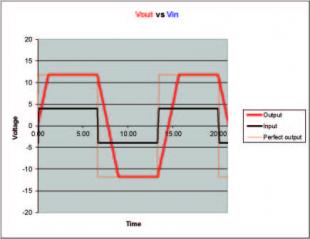Here, you can adjust the slew rate and also fire either a sine wave or a square wave into it. With a square wave, if the Op-Amp's slew rate "isn't up to it" the edges of the output square wave will simply slope more and more. With a sine wave, if the middle of the sine wave, where voltage is changing fastest, requires more "acceleration" than the Op-Amp can provide, you will simply head towards a triangular "sawtooth" waveform, where the Op-Amp changes its output voltage as fast as its slew rate allows .. rather like a Skoda trying to overtake a Ferrari!

Basics of Electronics ... a "Toybox" by Alan Murray, University of Edinburgh is licensed under a Creative Commons Attribution-NonCommercial-ShareAlike 4.0 International License.



